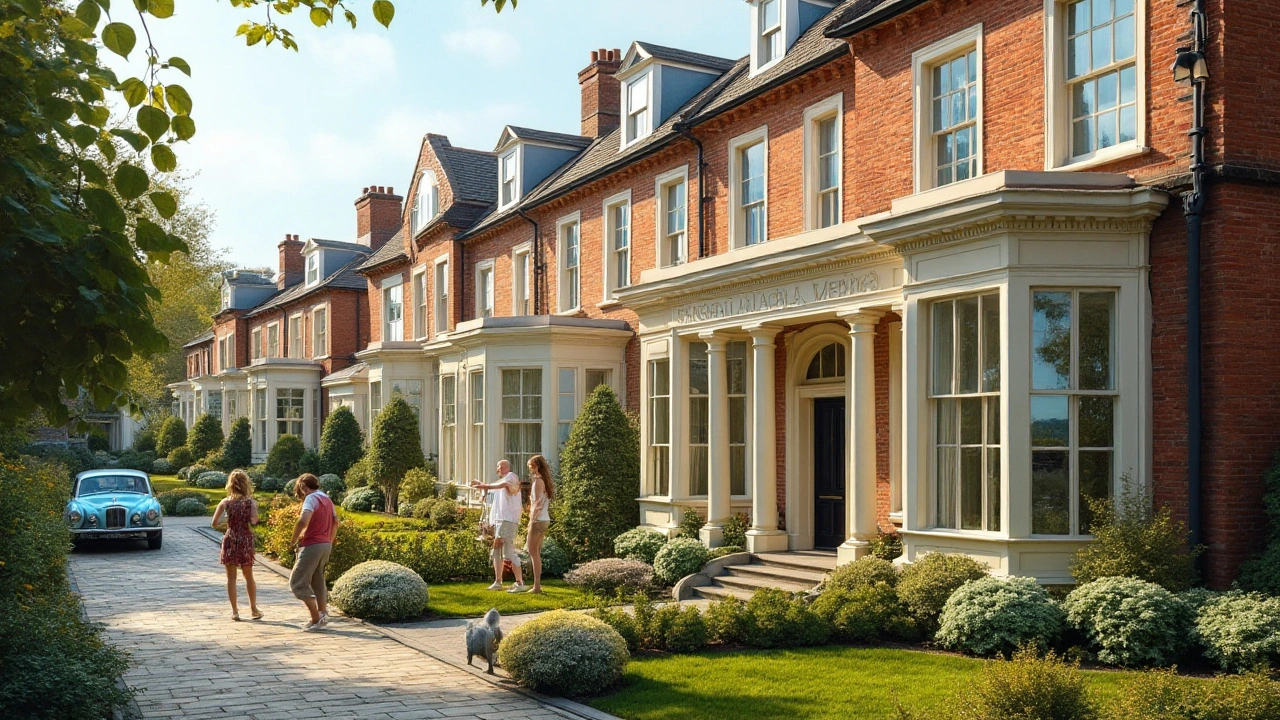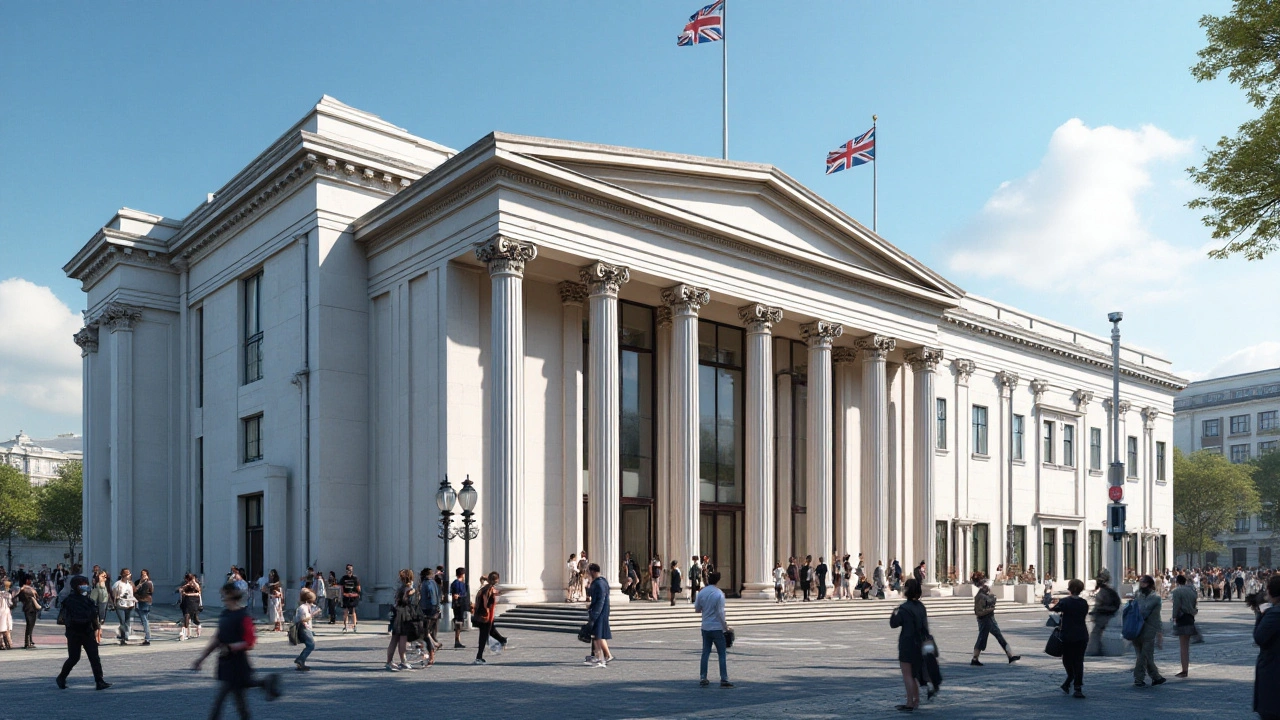The Lasting Influence of Federal Architecture in Modern Design
 Sep, 21 2024
Sep, 21 2024
Federal architecture has been a cornerstone of American design since the late 18th century. Known for its emphasis on symmetry, balance, and classical details, this architectural style originated in the early years of the United States.
Even though many decades have passed, its influence is still visible in modern buildings. From government offices to residential homes, the principles of Federal architecture continue to guide new designs and renovations.
Understanding the roots and characteristics of Federal architecture not only gives us an appreciation of history but also offers practical insights for current architectural practices. This article delves into the origins of this timeless style, showcases significant historical examples, highlights its modern-day relevance, and provides tips for incorporating Federal elements into contemporary designs.
- Origins and Characteristics
- Historical Examples
- Modern-Day Relevance
- Tips for Incorporating Federal Elements
Origins and Characteristics
Federal architecture, also known as Adam style, originated in the late 18th century and became a hallmark of early American architecture. This style derived its name from the Federal period in U.S. history, roughly between 1780 and 1830, when the young nation was finding its identity. The term 'Federal' was inspired by the early American government's structure, reflecting the aspirations of unity, harmony, and order.
The roots of Federal architecture can be traced back to the British neoclassical design, particularly the work of Scottish architects Robert and James Adam. They emphasized symmetry, proportion, and the use of classical Roman and Greek elements. These design principles resonated with the American ideals of democracy and classical antiquity, making the style immensely popular.
One of the defining characteristics of Federal architecture is its strict adherence to symmetry. The facades are uniformly balanced with evenly spaced windows and a central doorway, often adorned with semicircular fanlights and sidelights. This symmetry is not just an aesthetic choice but also a philosophical one, symbolizing the balance and fairness that the new American republic aimed to achieve.
Another notable feature is the use of classical elements such as columns, pediments, and domes, which were borrowed from ancient Roman and Greek architecture. These elements were not merely decorative but also conveyed a sense of grandeur and permanence, essential for a nation that was in its formative years. Intricate moldings, ornamental friezes, and the use of Palladian windows further accentuated the classical touch.
The interiors of Federal buildings were no less impressive. They often featured vaulted ceilings, grand staircases, and elaborate woodwork. The craftsmanship was meticulous, often inspired by pattern books that were popular at the time. An interesting fact is that many of these buildings used locally sourced materials, making them embodiments of regional identity.
"The Federal style represents an era when America was striving to establish itself as a culture of refinement and learning." - Mark Gelernter, Professor of Architecture
Federal architecture wasn’t limited to public buildings; it also found its way into private residences. Many affluent Americans of the time adopted this style for their homes, aiming to reflect their aspirations and belief in the new nation. These homes often featured elliptical or circular rooms, a unique characteristic that added to their elegance.
Interestingly, Federal architecture was also the first American style to be professionally designed, rather than being purely vernacular. This professional approach brought a level of consistency and refinement that was previously unseen. It set a precedent for future American architectural styles, influencing them in one way or another.
The style traveled well beyond the original thirteen colonies. As America expanded westward, so did the Federal style, morphing slightly to suit regional preferences but always retaining its core principles. This adaptability played a crucial role in its longevity and widespread appeal.
Federal architecture holds a special place in architectural history for its ability to combine aesthetics with philosophical and political ideals. Its emphasis on symmetry, balance, and classical elements has left an indelible mark, making it a timeless style that continues to inspire modern design.

Historical Examples
When exploring the rich history of Federal architecture, there are several iconic buildings that stand out as quintessential examples. Among these, the Massachusetts State House in Boston, designed by Charles Bulfinch in 1798, is often noted for its elegant symmetry and classical details. Its golden dome and decorative columns make it a landmark of the Federal style. Bulfinch's design elegantly combines practicality and beauty, creating a functional space that is visually stunning.
Another notable example is the White House in Washington, D.C., designed by James Hoban and first occupied in 1800. The White House showcases the typical Federal style with its refined proportions, emphasis on balance, and incorporation of classical elements like columns and porticos. This style was chosen to convey stability and dignity, aligning with the young nation's aspirations.
One must also mention Monticello, the home of Thomas Jefferson in Virginia. Jefferson, who was an avid admirer of classical architecture, designed Monticello himself. The building's symmetry, brick construction, and use of Doric columns reveal Jefferson's deep appreciation for the Federal style. Monticello not only reflects the elegance of its time but also the personal tastes and intellectual pursuits of one of America’s founding fathers.
In New York City, the Federal Hall, which once served as the nation’s first capitol building, remains a strong example of Federal architecture. Although the original building, where George Washington took his first oath of office, no longer exists, the significance of its Federal design influences remains crucial in architectural history. The current structure, completed in 1842, continues to embody Federal characteristics, from its balanced proportions to its classic wooden details.
"Federal architecture, with its roots in classical styles, represents a desire for order and harmony during a formative period in American history," notes architectural historian Jerry Lloyd.These historical examples showcase the lasting impact of Federal architecture not just as a style, but as a statement of the ideals and aspirations of a burgeoning nation. The timeless principles of symmetry, balance, and classical elegance have permeated the American architectural landscape, influencing countless designs over the centuries. Studying these historical buildings provides us with a deep understanding of how Federal architecture started and offers a lens through which we can appreciate its ongoing relevance.

Modern-Day Relevance
Federal architecture's influence is far from being just a relic of the past. Its principles of symmetry, balance, and classical details have found their way into modern design, resonating with contemporary aesthetics. One of the main reasons for this lasting impact is the timeless nature of its features. Americans, both individual homeowners and institutional designers, find the clean lines and proportional elements visually pleasing.
A notable example of Federal architecture's modern relevance is seen in the ongoing preservation projects across the United States. Historic buildings are transformed into modern-use spaces, such as offices or hotels, without losing their original charm. Experts argue these renovations help blend the old and new, providing functional yet aesthetically beautiful environments.
"The timeless appeal of Federal architecture lies in its ability to adapt to modern needs while maintaining its historical integrity," says Margaret Wilson, a renowned architectural historian.
Moreover, new constructions are frequently inspired by Federal design principles. You’ll find many contemporary homes with Federal features like columns, symmetrical facades, and meticulously designed windows. While these homes may incorporate modern materials and technologies, their underlying design principles remain rooted in Federal architecture.
Additionally, Federal architecture's emphasis on natural materials has found an eager audience in the sustainability movement. Stone, brick, and wood, commonly used in Federal buildings, are often more sustainable options compared to modern synthetic materials. At a time when eco-friendliness is a priority, leveraging Federal design elements can align aesthetic goals with environmental consciousness.
Practical Applications
For architects and designers looking to draw inspiration from Federal architecture, the principles can be applied to both interior and exterior elements. Inside, the use of symmetrical room layouts and classical detailing like crown moldings and chair rails brings a touch of Federal elegance. Outside, features such as evenly spaced windows, columns, and flat or low-pitched roofs create a balanced and harmonious appearance.
Interestingly, the adaptability of Federal architecture also extends to urban planning. City planners have recognized that the style’s emphasis on balance and symmetry can contribute to well-organized, aesthetically pleasing public spaces. This organized approach not only enhances visual appeal but also improves functionality, making spaces more navigable and enjoyable for the public.
Data from recent surveys indicate that properties featuring elements of Federal architecture tend to have higher market values compared to those with less distinctive styles. For real estate developers, this makes the integration of Federal elements a smart financial move, appealing to buyers who appreciate both historical charm and modern comfort.

Tips for Incorporating Federal Elements
Bringing Federal architecture into modern spaces might sound like a daunting task, but it’s really about paying attention to details and maintaining a balance. It’s not necessary to turn your home or building into a museum piece to capture the essence of this historic style. Understanding its main components will make it easier to blend these elements with contemporary design.
Begin with symmetry and proportions. Federal architecture is renowned for its symmetry and balanced look. You can achieve this by designing with a strong focus on even layouts and proportional rooms. Consider using matching windows and doors to maintain a harmonious appearance. For instance, placing windows evenly around a central door is a classic Federal move.
Columns and pilasters play a significant role in this style. Adding these elements to doorways or entrances can instantly give your space a Federal feel. You don’t have to install large, cumbersome columns; even subtle detailing can make a difference. Architect Robert A.M. Stern once said, “Architecture is a conversation across generations carried out over a community.” This means incorporating historical design elements in modern ways can still create impactful results.
Another key feature of Federal architecture is the use of classical details such as fanlights and sidelights around doors. A fanlight is a semicircular window often seen over front doors and can be customized to suit modern or minimalist aesthetics while keeping that historic touch. Sidelights, narrow windows flanking a door, allow natural light to enter while maintaining its found symmetry.
Materials and finishes should reflect the timeless nature of Federal design. Using wood, brick, and stone not only creates a lasting impression but also adds authenticity. Opting for high-quality materials will pay off both in your structure’s appearance and longevity. If possible, try to use reclaimed or repurposed materials to enhance both aesthetics and sustainability.
Color schemes in Federal style are usually quite restrained. Soft, muted colors like white, cream, and light gray can be contrasted with darker, richer hues such as navy blue or deep red for accents. This coloration helps keep the look timeless and adaptable to various interiors. Avoid overly bright or neon colors, as they can detract from the classic elegance associated with Federal architecture.
Integrate decorative elements like moldings and cornices without overwhelming the space. Subtle detailing goes a long way and adds to the overall feel without making the room appear gaudy or overly decorated. Think about wall moldings, chair rails, and coved ceilings that can add depth and interest.
Lighting plays an essential role in showcasing Federal architecture. Period-style lighting fixtures can tie the space together while maintaining modern functionality. Consider chandeliers or wall sconces that reflect the historical roots but with a modern twist. Recessed lighting can be used effectively to highlight these elements without being intrusive.
Finally, don’t underestimate the importance of furnishings and decor. Choosing furniture that complements the symmetry and elegance of Federal architecture can pull the entire look together. Think clean lines, elegant shapes, and minimalistic yet classic designs. Often, pieces that fall under the 'neoclassical' or 'colonial' categories work well.
Incorporating these tips not only helps preserve the beauty and legacy of Federal architecture but also provides functional and aesthetically pleasing living and working spaces. Whether you are renovating an old property or designing a new building, these guidelines can serve as a valuable resource.